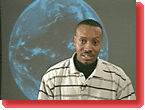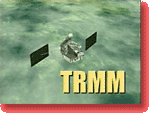M
a r s h a l l S h e p h e r d
P2K:
What's your job description? So things like, hurricanes, thunderstorms and cold front systems which produce tornadic activity. We try to develop new types of instrumentation to fly primarily aboard satellites to give us a new perspective on these storms. Can you imagine monitoring a hurricane approaching the coast of the United States or discovering the ozone hole without satellites. Well I couldn't. That's why we try to develop new types of instuments to see these large scale weather systesm from above. We can't really see a hurricane from the ground. We can't see the ozone hole from the ground or from an aircraft, we need a satellite perspective. It's really interesting to look at the Earth from a space-based perspective. You can really see the global circulation and the weather generating machine at work. So part of my job is to develop new scientific theory and instrumentation to help implement new observation of these weather and climate systems.
P2K: What do you like most about what you do? MS: What I enjoy most about what I do is that from 4th and 5th and 6th grade on I have been doing science projects where I formulate a hypothesis, I ask a question, I collect data to try to disprove or prove my hypothesis and then I find results that either support or refute that hypothesis. Well, effectively I do the same thing now except that I am using high tech, million dollar instrumentation that NASA has at its disposal, to actually do these same types of experiments. Guess the best part about it now is that I am doing these large science projects that I enjoy but now I get paid to do it! P2K: What set you on this career path? MS: I guess I should say a honey-bee did it. In other words, I really wanted to be an entomologist when I was a 5th grader. An entomologist, of course, studies insects. I was out catching bees in my yard one day, and got stung by a bee and found I was allergic to bee stings. And I said I better find something else. And I cam e across meteorology or weather. I did a science project called "Can a 6th grader predict the weather?" And I made all my weather instruments out of household materials, and I actually did quite well in the Georgia State Science Fair. And from that point on I knew that I wanted to be some type of weather scientist. Ironically I never wanted to be a weatherman on TV or predict weather. I always wanted to study weather. And that's how I became more of a research meteorologist or a research scientist. After attending Florida State which has one of the more reputable meteorology departments in the country, I knew that's what I wanted to do, and I just happened to end up at NASA after graduate school.
MS: The best day in my professional life so far has to be seeing a satellite go from development stage, as for example we saw with the TRMM satellite, actually watching that satellite launch, and zoom off into space. And to actually get that in space and orbiting and then start taking data and seeing really neat images like the ones we've never seen before, a couple of years ago, of Hurricane Bonnie. Actually seeing these missions go from the drawing boards, with the engineers to an actual reality and orbiting us in space is really an exhilarating experience and what I think really what being at NASA is all about. |


 P2K:
What was the best day in your professional life so far?
P2K:
What was the best day in your professional life so far?